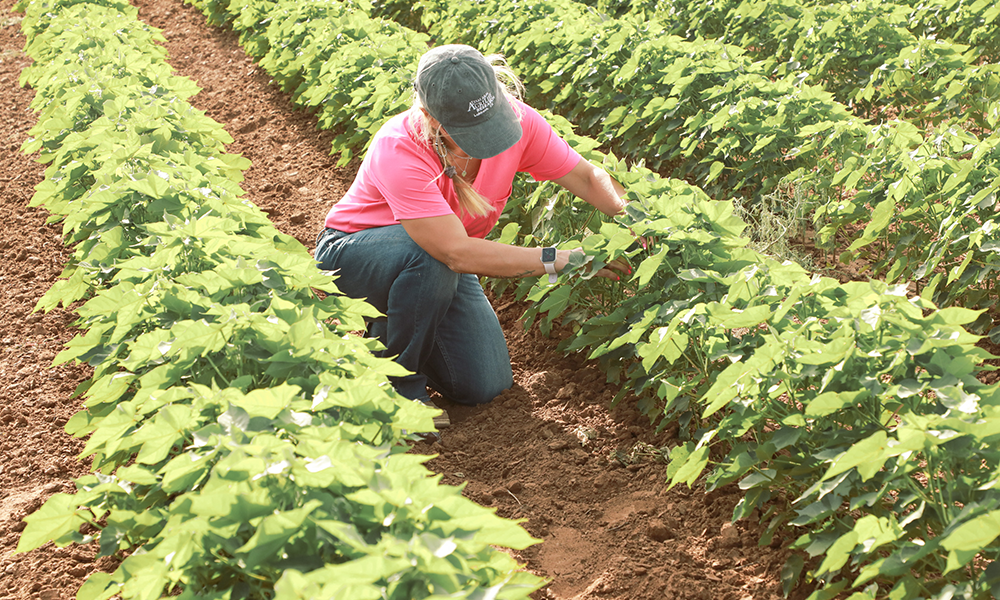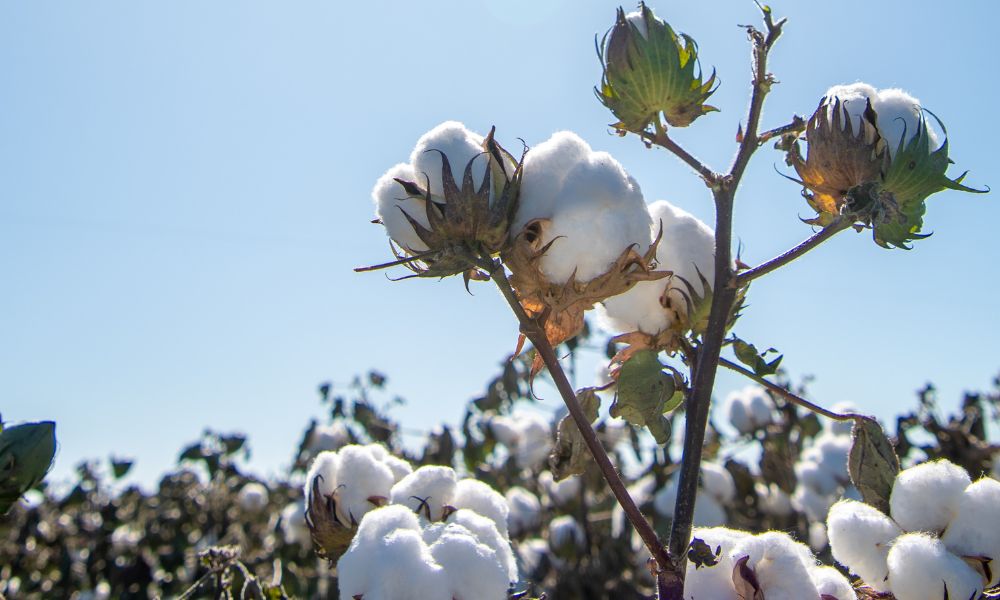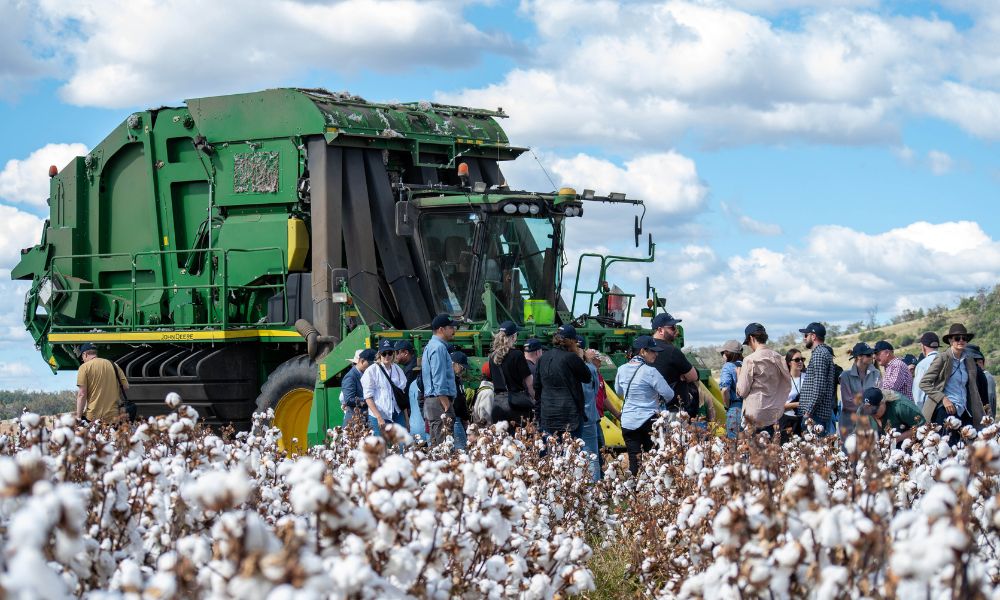U.S. Research and Practices to Reduce the Cotton Carbon Footprint
July 22, 2022
The updated Cotton LEADS℠ webpage offers insights into cotton agriculture’s carbon footprint and new research for emission reductions.
Compared to 1980, the U.S. cotton industry has already reduced its greenhouse gas (GHG) emissions by 25%, and the industry is committed to continuing progress. The rate of improvement has leveled off in the past decade1, but growers and researchers across the country are working to change that. Together, they are creating paths forward toward the industry-wide goal to reduce GHGs emitted during production by 39% by 2025 compared to the 2015 baseline.
Climate-Smart Cotton Production
 To reach the U.S. industry goal, sustainability and agriculture experts representing the U.S. cotton industry have developed a detailed hierarchy of strategies and tactics for reducing and capturing carbon across the global cotton value chain. This hierarchy serves as a set of recommendations to help the industry focus on improvements that are realistic, meaningful, and effective for the greatest number of producers and supply chain partners.
To reach the U.S. industry goal, sustainability and agriculture experts representing the U.S. cotton industry have developed a detailed hierarchy of strategies and tactics for reducing and capturing carbon across the global cotton value chain. This hierarchy serves as a set of recommendations to help the industry focus on improvements that are realistic, meaningful, and effective for the greatest number of producers and supply chain partners.
In this hierarchy, the two most important types of actions are increasing production efficiency and practicing regenerative agriculture to increase soil carbon. U.S. cotton growers are leading the way in both of these areas by implementing a full suite of climate-smart agriculture practices – practices that also help improve yields and have the potential to reduce operating costs. They are working with researchers to decrease the amount of fertilizer required for high fiber yields, while enabling cotton plants and the soil to capture and sequester more carbon from the atmosphere.
Increasing Production Efficiency by Optimizing Fertilizer Use
Nitrogen is one of the most vital nutrients for any plant. If growers do not give their crop enough nitrogen fertilizer, the cotton cannot grow to its full potential, and the yield will be negatively impacted. If growers apply more than the plants can use, however, the excess nitrogen is lost into water or air as pollution, including the greenhouse gas nitrous oxide. Precision agriculture practices like soil sampling, plant tissue sampling, the use of other sensors and variable rate fertilizer application enable growers to more accurately measure and predict their crop’s nutrient needs and only apply what they need where they need it– and thus optimize fertilizer use.
The U.S. cotton industry knows how important it is to regularly reevaluate the generally recommended fertilizer rates, since new plant varieties and changing environmental conditions can affect how much nitrogen cotton needs. Cotton Inc. and the Fertilizer Institute, for example, are conducting multi-year research studies to identify the most profitable and sustainable nitrogen rates and then share the insights and practical applications with cotton growers around the country.
Explore the latest research designed to help farmers use nitrogen fertilizer wisely. Go to our Carbon Footprint page.
Practicing regenerative agriculture to increase soil carbon
 Regenerative cotton agriculture aims not to “do less harm,” but to positively influence climate resilience, water quantity and quality, biodiversity and soil health. Practices like conservation tillage and cover crops enable the soil to sequester more carbon while helping reduce the need for nitrogen fertilizer.
Regenerative cotton agriculture aims not to “do less harm,” but to positively influence climate resilience, water quantity and quality, biodiversity and soil health. Practices like conservation tillage and cover crops enable the soil to sequester more carbon while helping reduce the need for nitrogen fertilizer.
U.S. researchers are evaluating the degree to which different practices increase the amount of carbon stored in the soil and helping growers understand what’s best for the long-term health of their farms and the environment. Cotton Inc. is working with other industry partners, like the Soil and Water Outcomes Fund and the Soil Health Institute’s U.S. Regenerative Cotton Fund, to encourage widespread adoption of soil health management systems that will draw carbon dioxide out of the atmosphere.
The creation of the U.S. Cotton Trust Protocol (CTP) is another important step in engaging cotton growers. By helping growers measure, benchmark and reduce their GHG over time, the program aims to accelerate continuous improvement in climate-smart, regenerative agricultural practices.
Learn about the link between soil health and carbon emissions on our Carbon Footprint page.
Despite slowed progress on GHG emissions in recent years, the U.S. cotton industry has made major strides in aligning around sustainability. Continuing research, grower outreach and shared insights are critical. The U.S. cotton industry is committed to leading the way in reducing cotton’s carbon footprint and helping sustainable cotton programs, brands and NGOs around the world align on effective, science-based climate action.
1 Field to Market: The Alliance for Sustainable Agriculture. (2021). Environmental Outcomes from On-Farm Agricultural Production in the United States (Fourth Edition). ISBN: 978-0-578-33372-4.














Recent Comments